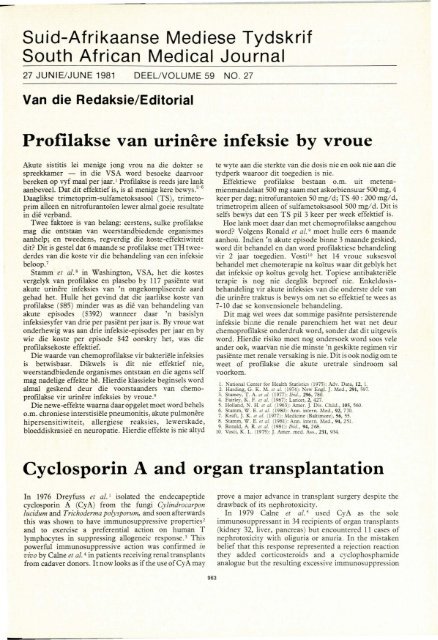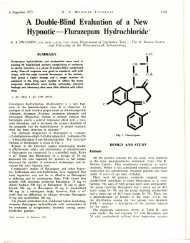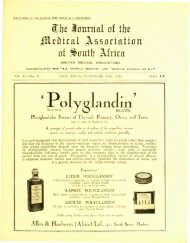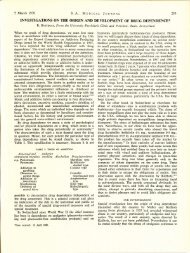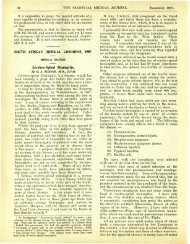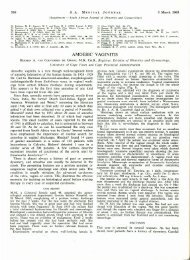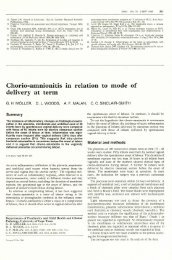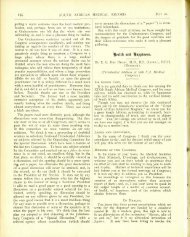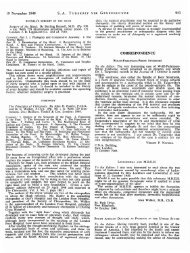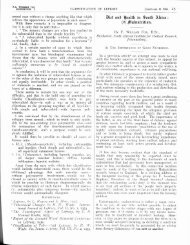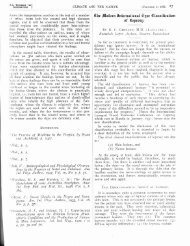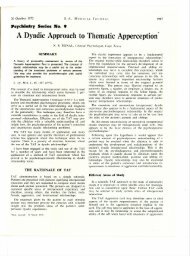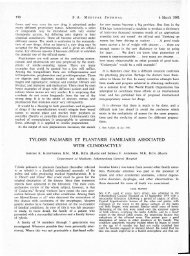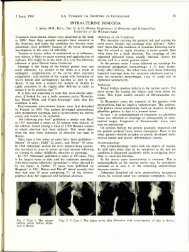Profilakse van urinere infeksie by vroue Cyclosporin A and organ ...
Profilakse van urinere infeksie by vroue Cyclosporin A and organ ...
Profilakse van urinere infeksie by vroue Cyclosporin A and organ ...
You also want an ePaper? Increase the reach of your titles
YUMPU automatically turns print PDFs into web optimized ePapers that Google loves.
Suid-Afrikaanse Mediese Tydskrif<br />
South African Medical Journal<br />
27 JUNIE/JUNE 1981 DEELlVOLUME 59 NO. 27<br />
Van die Redaksie/Editorial<br />
<strong>Profilakse</strong> <strong>van</strong> <strong>urinere</strong> <strong>infeksie</strong> <strong>by</strong> <strong>vroue</strong><br />
Akute sistitis lei menige jong vrou na die dokter se<br />
spreekkamer - in die VSA word besoeke daarvoor<br />
bereken op vyf ma31 per jaar. 1 <strong>Profilakse</strong> is reeds jare lank<br />
aanbeveel. Oat dit effektief is, is 31 menige kere bewys.2-6<br />
Daaglikse trimetoprim-sulfametoksasool (TS), trimetoprim<br />
aUeen en nitrofurantolen lewer a1mal goeie resultate<br />
in die verb<strong>and</strong>.<br />
Twee faktore is <strong>van</strong> belang: eerstens, sulke profilakse<br />
mag die ontstaan <strong>van</strong> weerst<strong>and</strong>biedende crganismes<br />
aanhelp; en tweedens, regverdig die koste-effektiwiteit<br />
dit? Dit is gestel dat 6 ma<strong>and</strong>e se profilakse met TH tweederdes<br />
<strong>van</strong> die koste vir die beh<strong>and</strong>eling <strong>van</strong> een <strong>infeksie</strong><br />
beloop.7<br />
Stamm er al. 8 in Washington, VSA, het die kostes<br />
vergelyk <strong>van</strong> profilakse en plasebo <strong>by</strong> 117 pasiente wat<br />
akute <strong>urinere</strong> <strong>infeksie</strong>s <strong>van</strong> 'n ongekompliseerde aard<br />
gehad het. Hulle het gevind dat die jaarlikse koste <strong>van</strong><br />
profliakse (S85) minder was as die <strong>van</strong> beh<strong>and</strong>eling <strong>van</strong><br />
akute episodes ($392) wanneer daar 'n basislyn<br />
<strong>infeksie</strong>syfer <strong>van</strong> drie per pasient per jaar is. By <strong>vroue</strong> wat<br />
onderhewig was aan drie <strong>infeksie</strong>-episodes per jaar en <strong>by</strong><br />
wie die koste per episode $42 oorskry het, was die<br />
profliaksekoste effektief.<br />
Die waarde <strong>van</strong> chemoprofliakse vir bakteriele <strong>infeksie</strong>s<br />
is benvisbaar. Dikwels is dit nie etlektief nie,<br />
weerst<strong>and</strong>biedende <strong>organ</strong>ismes ontsraan en die agens self<br />
mag nadelige effekte he. Hierdie klassieke beginsels word<br />
31mal geskend deur die voorsta<strong>and</strong>ers <strong>van</strong> chemoprofliakse<br />
vir <strong>urinere</strong> <strong>infeksie</strong>s <strong>by</strong> <strong>vroue</strong>. 9<br />
Die newe-effekte waarna daaropgelet moet word behels<br />
o.m. chroniese interstisiele pneumonitis, akure pulmonere<br />
hipersensitiwiteit, allergiese reaksies, lewerskade,<br />
bloeddiskrasiee en neuropatie. Hierdie effekte is nie altyd<br />
te wyre aan die sterkte <strong>van</strong> die dosis nie en ook nie aan die<br />
tydperk waaroor dit toegedien is nie.<br />
Effektiewe profilakse bestaan o.m. uit metenamienm<strong>and</strong>elaat<br />
500 mg saam met askorbiensuur 500 mg, 4<br />
keer per dag; nirrofurantolen 50 mg/d; TS 40 : 200 mg/d,<br />
trimetroprim alleen of sulfametoksasool 500 mg/d. Dit is<br />
selfs bew'ys dat een TS pil 3 keer per week effektief is.<br />
Hoe lam moet daar dan met chemoprofilakse aangehou<br />
word? Volgens Ronald er at. 9 moet hulle eers 6 ma<strong>and</strong>e<br />
aanhou. Indien 'n akure episode binne 3 ma<strong>and</strong>e geskied,<br />
word dit beh<strong>and</strong>el en dan word profilaktiese beh<strong>and</strong>eling<br />
vir 2 jaar toegedien. Vosti 10 het 14 <strong>vroue</strong> suksesvol<br />
beh<strong>and</strong>el met chemoterapie na kOltus waar dit geblyk het<br />
dat <strong>infeksie</strong> op kOltus gevolg het. Topiese antibakteriele<br />
terapie is nog nie deeglik beproef nie. Enkeldosisbeh<strong>and</strong>eling<br />
vir akure <strong>infeksie</strong>s <strong>van</strong> die onderste dele <strong>van</strong><br />
die <strong>urinere</strong> trakrus is bewys om net so effektief te wees as<br />
7-10 dae se konvensionele beh<strong>and</strong>eling.<br />
Dit mag wel wees dat sommige pasiente persisterende<br />
<strong>infeksie</strong> binne die ren31e parenchiem het wat net deur<br />
chemoprofilakse onderdruk word, sonder dat dit uirgewis<br />
word. Hierdie risiko moet nog ondersoek word soos vele<br />
<strong>and</strong>er ook, waar<strong>van</strong> nie die minste 'n geskikte regimen vir<br />
pasiente met renale versaking is nie. Dit is ook nodig om te<br />
weet of profI1akse die akute uretr31e sindroom sal<br />
voorkom.<br />
L National Center for Health Statistics (1975): Adv. Data, 12, 1.<br />
2. Harding, G. K. M. ec al. (1974): New Engl. J. M.ed., 291, 597.<br />
3. Stamey, T. A. ec al. (197/ : Ibid., 296, 780.<br />
4. Fairley, K. F. ec al. (1967): Lancet, 2, 427.<br />
5. Holl<strong>and</strong>, N. H. ec al. (1963): Amer. J. Dis. Child., lOS, 560.<br />
6. Stamm, W. E. ec al. (1980): Ann. intern. Med., 92, 770.<br />
7. Kraft, J. K. ec al. (1977): Medicine (Baltimore), 56,55.<br />
8. Stamm, \X'. E. ec al. (1981): Ann. intern. Med., 94, 251.<br />
9. Ronald, A. R. ec al. (198!): Ibid., 94,268.<br />
10. Vosti, K. L. (1975): J. Amer. med. Ass., 231, 934.<br />
<strong>Cyclosporin</strong> A <strong>and</strong> <strong>organ</strong> transplantation<br />
In 1976 Dreyfuss er al. 1 isolated the endecapeptide<br />
cyclosporin A (CyA) from the fungi Cylindrocarpon<br />
lucidum <strong>and</strong> Tn·choderma polysporum, <strong>and</strong> soon afterwards<br />
this was shown to have immunosuppressive propenies 2<br />
<strong>and</strong> to exercise a preferential action on human T<br />
lymphocytes in suppressing allogeneic response. 3 This<br />
powerful immunosuppressive action was confirmed in<br />
vivo <strong>by</strong> C31ne er al. 4 in patients receiving renal transplants<br />
from cadaver donors. Itnow looks as ifthe use ofCyA may<br />
963<br />
prove a major ad<strong>van</strong>ce in transplant surgery despite the<br />
drawback of its nephrotoxicity.<br />
In 1979 Calne er al. 5 used CyA as the sole<br />
immunosuppressant in 34 recipients of <strong>organ</strong> transplants<br />
(kidney 32, liver, pancreas) bur encountered 11 cases of<br />
nephrotoxicity with oliguria or anuria. In the mistaken<br />
belief that this response represented a rejection reaction<br />
they added corricosteroids <strong>and</strong> a cyclophosphamide<br />
analogue bur the resulting excessive immunosuppression
J with<br />
964 SA MEDICAL JOURNJl:L 27 JUNE 1981<br />
led to a high incidence of bacterial, viral <strong>and</strong> fungal<br />
infection <strong>and</strong> to the development of 3 lymphomas. When<br />
the dose of CyA was reduced severe graft rejection<br />
developed, bur this was rapidly controlled <strong>by</strong> substituting<br />
azathioprine <strong>and</strong> prednisolone for CyA. They also<br />
believed that the use of CyA was made safer <strong>by</strong> forced<br />
diuresis.<br />
Klintmalm er al. 6 of Colorado have recently reported<br />
the use of CyA in liver <strong>and</strong> kidney transplantation bur<br />
believe that early kidney failure in these cases is more<br />
likely to be due to graft rejection than to drug toxicity.<br />
However, they noted nephrotoxicity after 13 - 22 days in 6<br />
out of 12 patients with orthotopic liver transplants treated<br />
with CyA in doses of 11 - 20 mg/kg daily. In 4 renal<br />
transplant cases there was also evidence ofnephrotoxicity,<br />
sharp rises in serum creatinine <strong>and</strong> blood urea<br />
nitrogen on doses as low as 5,2 mg/kg daily. However,<br />
they found that this toxicity was easy to combat <strong>by</strong><br />
lowering the dose of CyA <strong>and</strong>/or a switch to azathioprine<br />
as immunosuppressant.<br />
Since there is clearly a need to establish a dose range<br />
that will produce adequate immunosuppression withour<br />
nephrotoxicity, Keown er al. i of the University of<br />
Western Ontario have monitored serum levels ofCyA <strong>and</strong><br />
measured these against the immune response in kidney<br />
recipients to donor antigens after a transplant. The drug<br />
was given intramuscularly during the first 48 hours <strong>and</strong><br />
then orally as a dose of 17,5 mg/kg/d.<br />
The graft functioned at once in 5 our of 6 cases <strong>and</strong> the<br />
authors suggest that the drug is best given orally twice a<br />
day for adequate immunosuppression. They think that it<br />
has a biological half-life of4 - 6 hours <strong>and</strong> in the dose given<br />
maintains a continuous serum level in excess of0,1 pg/ml<br />
for 12 hours. They are, however, unhappy about a slowly<br />
progressive deterioration in renal function in 4 patients,<br />
beginning after abour 3 months.<br />
Calne er al. 8 have J;ecently reviewed their results with<br />
the use of CyA in renal, hepatic <strong>and</strong> pancreatic grafts <strong>and</strong><br />
seem very satisfied with its use so far. They describe<br />
results with three groups of patients: (z) 39 patients with<br />
kidney grafts given CyA as the initial sole<br />
immunosuppressive agent; (iz) 14 patients with liver or<br />
kidney grafts converted to CyA treatment; (iiz) 9 patients<br />
with segmental pancreatic allografts for insulindependent<br />
diabetes.<br />
Their results with CyA in patients given cadaveric<br />
renal allografts were very much better than had been<br />
obtained before. The predicted graft survival at 1 year<br />
was 86%, bur the group included 5 patients in whom CyA<br />
did not control rejection <strong>and</strong> who were changed to<br />
azathioprine <strong>and</strong> corticosteroids with satisfactory results.<br />
They disagree with Starzl er al.,9 who suggest that CyA<br />
should be combined with corticosteroids, because of the<br />
British experience of a high incidence of infections <strong>and</strong><br />
lymphoma with this combination.<br />
With liver allografts they start CyA only when ·the<br />
patient's condition is stable, <strong>and</strong> find that hepatic <strong>and</strong><br />
renal function can be satisfactorily maintained with this<br />
drug alone, but the follow-up term is short. CyA has also<br />
controlled rejection in some cases of pancreas<br />
transplantation without the need for corticosteroids; their<br />
problem is more the prevention of exocrine secretion <strong>by</strong><br />
blocking of the pancreatic ducts.<br />
The ease with which patients may be changed to <strong>and</strong><br />
from CyA provides a valuable alternative immunosuppressive<br />
tool, <strong>and</strong> a r<strong>and</strong>omized multicentre trial is<br />
now being planned to compare CyA with the conventional<br />
azathioprine-eorticosteroid regimen in recipients of<br />
cadaver renal allografts.<br />
1. Dreyfuss, M., Haerri, E., Hoffman, H. ec al. (1976): Eur. J. appl. Microbial., 3,<br />
125.<br />
2. Bore!, J. F. (1976): Immunol.ogy, 31, 631.<br />
3. Gordon, M. Y. <strong>and</strong> Singer, J. W. (1979): Nature, 279, 433.<br />
4. Calne, R. Y., White, D. J. G., Thiru, S. et al. (1978): Lancer, 2,1323.<br />
5. Calne, R. Y., Rolles, K., Whire, D. J. G. et al. (1979): Ibid., 2, 1033.<br />
6. Klinrmalm, G. B. G., Iwarsuki, S. <strong>and</strong> 5rarzl, T. E. (1981): Ibid. L 1,470.<br />
7. Keown, P. A., Sriller, C. R., Ulan, R. A. er al. (1981): Ibid., 1,686.<br />
8. Calne, R. Y., Whire, D. J. G., E<strong>van</strong>s, D. B. (1981): Bri!. med. J., 282, 934.<br />
9. Srarzl, T. E., Weil, R., Iwarsuki, S; et al. (1981): Surg. Gynec. Obsre!., 151,17.


